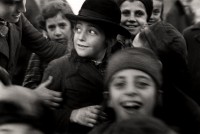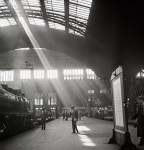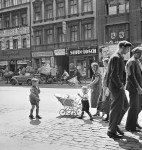 Photographer Roman Vishniac’s vast archive documenting Jewish life in Eastern Europe before and after World War II is being digitized and made available to the public. The joint project of the International Center of Photography (ICP) in New York and the United States Holocaust Memorial Museum in Washington, D.C., has already scanned almost 9,000 negatives that have never been seen or published before. More negatives continue to be added all the time. Ultimately 40,000 items — photographic prints, contact sheets, films, letters, interviews, recordings — will be scanned and uploaded to the dedicated website: vishniac.icp.org.
Photographer Roman Vishniac’s vast archive documenting Jewish life in Eastern Europe before and after World War II is being digitized and made available to the public. The joint project of the International Center of Photography (ICP) in New York and the United States Holocaust Memorial Museum in Washington, D.C., has already scanned almost 9,000 negatives that have never been seen or published before. More negatives continue to be added all the time. Ultimately 40,000 items — photographic prints, contact sheets, films, letters, interviews, recordings — will be scanned and uploaded to the dedicated website: vishniac.icp.org.
The goal of the project, in addition to making this precious record widely available to all who wish to study it, is to crowdsource as much information as they can about the photographs.
ICP and the Museum invite scholars and students across a wide range of disciplines, families across generations, and members of the public to explore the archive, contribute their research and family stories, and help identify the people and places depicted in the images. The diverse perspectives brought together by this unique effort, and by the work of a dedicated group of internationally recognized scholars, have already yielded exciting discoveries.
“We believe this initiative represents a new model for digital archives, and we are excited to bring this collection to an even-wider audience,” said Mark Lubell, ICP’s executive director. “Our shared goal is to make the images available for further identification and research, deepening our knowledge of Vishniac’s work and the people and places he recorded in his images.”
 Born near Saint Petersburg, Russia, in 1897, Roman Vishniac received his first camera as a gift on his seventh birthday. Even as he studied biology and zoology in college, he continued to explore photography and was an accomplished amateur photographer by the time he left Russia in 1920. He and his new wife joined his émigré family in Weimar Berlin. Throughout the 1920s, Roman took copious pictures documenting the street life of the city, particularly his own neighborhood populated primarily by Russian Jews. He experimented with framing and composition, and even built his own darkroom in his apartment.
Born near Saint Petersburg, Russia, in 1897, Roman Vishniac received his first camera as a gift on his seventh birthday. Even as he studied biology and zoology in college, he continued to explore photography and was an accomplished amateur photographer by the time he left Russia in 1920. He and his new wife joined his émigré family in Weimar Berlin. Throughout the 1920s, Roman took copious pictures documenting the street life of the city, particularly his own neighborhood populated primarily by Russian Jews. He experimented with framing and composition, and even built his own darkroom in his apartment.
In the wake of Adolf Hitler’s appointment as Chancellor of Germany in 1933, Jews are increasingly marginalized. Vishniac kept taking pictures, documenting the increasing dominance of anti-Semitic laws and attitudes in Berlin. He soon traveled further afield. From 1935 to 1938, the Paris headquarters of the American Jewish Joint Distribution Committee (AJDC) commissioned him to photograph rural Jewish communities in Central and Eastern Europe. They aimed to publicize the images in the United States to raise awareness of the deep need in these impoverished communities.
 In 1938 and 1939, the AJDC sent Vishniac to Poland and the Netherlands to photograph Jewish refugees expelled from Germany. From the Netherlands he traveled to France, working as a freelance photographer. In 1940, he gave all his negatives to a friend in Paris, asking him to take them to the United States. That was very well timed since shortly thereafter he was arrested and interned in Camp du Ruchard in Clichy for three months. He got out and managed to leave France for Lisbon where he reunites with his wife and children and together they flee to New York.
In 1938 and 1939, the AJDC sent Vishniac to Poland and the Netherlands to photograph Jewish refugees expelled from Germany. From the Netherlands he traveled to France, working as a freelance photographer. In 1940, he gave all his negatives to a friend in Paris, asking him to take them to the United States. That was very well timed since shortly thereafter he was arrested and interned in Camp du Ruchard in Clichy for three months. He got out and managed to leave France for Lisbon where he reunites with his wife and children and together they flee to New York.
His pre-war negatives had finally reached him in 1942 and prints of some of them had already been displayed in an attempt to draw attention to the plight of Europe’s Jews. The vast majority of them, however, remained unprinted negatives, and Vishniac never labeled them or annotated them in any way. That’s why it’s so important that those negatives are now published online. There are still people alive who may be able to recognize the people and places in the pictures but the clock is ticking. Others may recognize something they’ve seen in family photographs even if they weren’t born when Vishniac took the pictures.
You can search the collection by keyword, date, location, etc., or you can browse through all 8999 scanned negatives. Register here to help with the labeling.